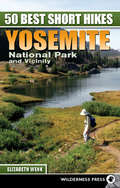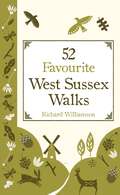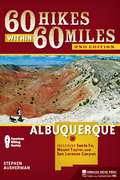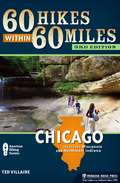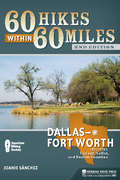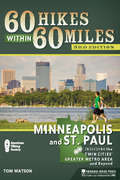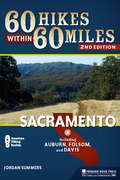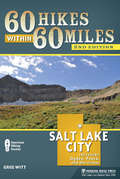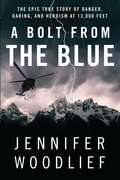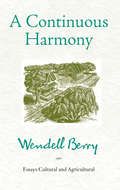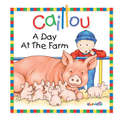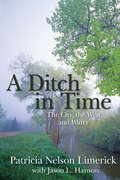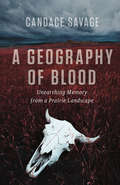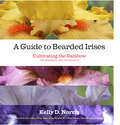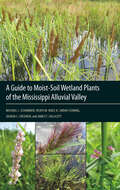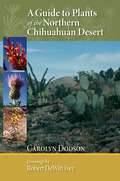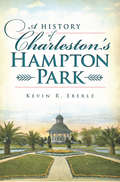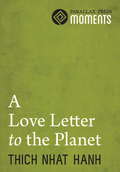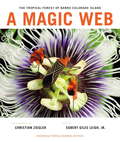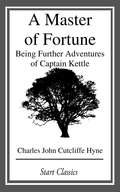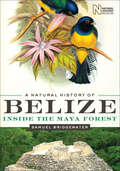- Table View
- List View
50 Best Short Hikes: Yosemite National Park and Vicinity
by Elizabeth Wenk50 Best Short Hikes: Yosemite National Park and Vicinity leads hikers of all skill levels to some of the most stunning landscapes Yosemite has to offer including: bubbling alpine creeks, smooth glaciated slabs, giant sequoias, deep dark blue lakes, and rock as far as the eye can see. In addition to in-depth hike descriptions, the author has also included information about the parks natural history, complex landscape, and its human history. Additional information includes tips on keeping yourself and your family safe, the park's natural predators, and helpful weather information.
52 Favourite West Sussex Walks
by Richard WilliamsonRichard Williamson’s weekly walking column is one of the most popular features in the Chichester Observer, Worthing Observer and West Sussex Gazette. Now he has compiled his favourite walks – one for every week of the year. With hand-drawn route maps and practical notes, these routes can be covered easily in an afternoon.
52 Favourite West Sussex Walks
by Richard WilliamsonRichard Williamson’s weekly walking column is one of the most popular features in the Chichester Observer, Worthing Observer and West Sussex Gazette. Now he has compiled his favourite walks – one for every week of the year. With hand-drawn route maps and practical notes, these routes can be covered easily in an afternoon.
60 Hikes Within 60 Miles: Albuquerque
by Stephen AushermanThis newly updated and revised edition of 60 Hikes within 60 Miles: Albuquerque hits classic trails and uncovers paths where no guidebook has gone before. This is the essential guide to north-central New Mexico, from the black lava badlands in El Malpais National Monument to the cool aspens in Santa Fe National Forest. Explore newly opened lands in the Ojito Wilderness and the Valles Caldera, or revisit the past with nostalgic walks along the Rio Grande and Route 66. Hikes lead to ancient pueblos, ghost towns, slot canyons, strange hoodoos and other treasures in the heart of New Mexico, all just a daytrip or less from the Duke City.Each chapter serves as both a navigational aide and an interpretive guide to familiarize hikers with wondrous destinations in the Land of Enchantment. From the black lava badlands in El Malpais National Monument to the aspen trees in Santa Fe National Forest, the Albuquerque area is filled with beautiful wilderness perfect for exploration. This comprehensive guidebook outlines the level of difficulty for each hike, and includes extensive maps and trail profiles to assist hiking enthusiasts and day-trippers alike. Experience the Rio Grande, old Route 66, ancient pueblos, ghost towns, and other charms of the area with this essential guide.
60 Hikes Within 60 Miles: Chicago
by Ted VillaireIn addition to Chicago's numerous cultural and athletic activities, there are many excellent opportunities to explore Mother Nature's bounty. From the dunes of Lake Michigan to the hills and lakes of the northwest to the prairies of the south, hikers will find a trail to their liking in this updated edition of 60 Hikes within 60 Miles: Chicago.Hikes were chosen for their scenic appeal, but they were also chosen for their historic attractions. The extensive key-at-a-glance information makes it a snap to choose a hike based on length, difficulty, and scenery. Helpful lists highlight the best hikes for children, for wildlife viewing, and other categories.Whether a long-time Chicago resident or vacationer to the area, this updated guide will make choosing the right hike easy and enjoyable.
60 Hikes Within 60 Miles: Dallas/Fort Worth
by Joanie Sanchez60 Hikes within 60 Miles: Dallas / Fort Worth covers the best trails the metroplex has to offer, including popular trails as well as lesser-known paths no guidebook has covered before. This is the essential guide you'll need for hiking in the Dallas / Fort Worth Metroplex. Choose a trek alongside ancient dinosaur tracks at Dinosaur Valley State Park, or follow fresh prints of live coyote and white-tailed deer at Lake Mineral Wells. Explore remnants of Texas' disappearing blackland prairie, or wander amongst the dense hardwood forests of the riparian wetlands. A hike for every mood, you can pick a quiet hike to a secluded pecan grove or an upbeat populated hike to a State Champion Oak Tree - or maybe you just want to feel like a pioneer as you hike through the wilderness of the LBJ National Grasslands. Hikes include treks through open prairies, rolling hillsides, lakeside beaches, and other treasures all found just a daytrip or less from the Dallas / Fort Worth Metroplex.
60 Hikes Within 60 Miles: Houston
by Laurie Roddy60 Hikes within 60 Miles: Houston uncovers hikes around Houston that previously had gone unnoticed. This is the essential guide to this area, from the Big Thicket of east Texas to the coast of Galveston Island. Explore most of the 138-mile Lone Star Trail with over a dozen hikes breaking up the trail into manageable segments. Hikes lead to old native homesteads, native prairies, deep forests, riparian woodlands, urban byways, wildlife preserves along the Great Texas Coastal Birding Trail, wetlands, and numerous bayous and waterways. Each chapter serves as both a navigational aide and an interpretive guide to familiarize hikers with wondrous destinations in and around The Bayou City.
60 Hikes Within 60 Miles: Minneapolis and St. Paul
by Tom WatsonWithin the seven county "metro" area that encompasses the Twin Cities of Minneapolis and St. Paul lies a network of hundreds of miles of trails. Hikes were selected to be representative of the area, showcasing the park or region's main attractions or personality. Some of these trails are broad, paved corridors through multi-use parks generously developed to provide a myriad of recreational opportunities for the young and old, the robust trekker, and the casual stroller.Trails are based in a wide range of areas such as walkways of grass winding through majestic stands of Minnesota hardwoods. Other hikes are spider-web networks that remind one of well-used deer trails. Some are isolated within a pocket of greenery surrounded by vast ribbons of freeway concrete and broad subdivisions. Others are woven within the fabric of parklands so expansive that you could literally spend weeks hiking all the networks lying within their folds. Twin Cities' hiking is huge so get the guide that gets you there and back.This decisive guide to day hikes in the Twin Cities' area just got better. Updated maps, new hikes, new photos, and brand-new trailhead coordinates make Tom Watson's authoritative guide even more useful than before.
60 Hikes Within 60 Miles: Sacramento
by Jordan SummersCarefully researched on foot, hiking enthusiast Jordan Summers introduces area residents and visitors to an array of the best day hikes from casual riverside nature hikes to rugged foothill treks within roughly an hour's drive of Sacramento.Filled with detailed descriptions of firsthand trail notes, this newly updated edition of 60 Hikes Within 60 Miles: Sacramento helps hikers discover their choices with concise at-a-glance information highlighting details such as location, access, directions, distances, scenery, and preparation details that help hikers get the most from each outing. Precise maps, descriptive text, photos, and trailhead coordinates guide you on your way quickly and keep you on route reliably. Discover the varied geology, the cultural history, and the natural beauty of the foothills, mother lode, and delta regions in 60 Hikes Within 60 Miles: Sacramento.
60 Hikes Within 60 Miles: Salt Lake City
by Greg Witt60 Hikes Within 60 Miles: Salt Lake City is the only guidebook that pinpoints the most exceptional hikes in the area. It contains meticulous trail descriptions that range from comfortable strolls for families to difficult treks for those looking for a challenging workout. Extensive key-at-a-glance information makes it easier to choose a hike based on length, difficulty, or scenery. A helpful list of hikes in the front of the book highlights those with special interests - best hikes for children, scenic hikes, hikes good for wildlife viewing, best hikes for runners, and more. Each hike report includes commentary on trailside geology, flowers, and wildlife. Historical notes provide fascinating details about early miners, trailblazers, the Pony Express, and Mormon pioneers.Nestled in the western flank of the Rockies, Salt Lake City provides ready access to a stunning array of hiking options amid alpine lakes, snow-draped mountain peaks, fragrant evergreen forests, deep canyon waterfalls, granite towers, and flowered cirques. Within 60 miles of Salt Lake City there are thousands of square miles of national forest, National Wilderness Areas, state parks and designated recreation areas to explore.Now, with this updated edition of 60 Hikes within 60 Miles: Salt Lake City, whether lacing up boots, stepping into sneakers or strapping on snowshoes, Salt Lake City is even more accessible for hikers.
A Bolt from the Blue: The Epic True Story of Danger, Daring, and Heroism at 13,000 Feet
by Jennifer WoodliefFIVE INJURED CLIMBERS. TEN SEASONED RANGERS. ONE IMPOSSIBLE RESCUE. On the afternoon of July 26, 2003, six vacationing mountain climbers ascended the peak of the Grand Teton in Jackson Hole, Wyoming. Rain and colliding air currents blew in, and soon a massive electrical charge began to build. As the group began to retreat from its location, a colossal lightning bolt struck and pounded through the body of every climber. One of the six died instantly, one lay critically injured next to her body, and four dangled perilously into the chasm below. In riveting, page-turning prose, veteran journalist Jennifer Woodlief tells the story of the climb, the arrival of the storm, and the unprecedented rescue by the Jenny Lake Rangers, one of the most experienced climbing search-and-rescue teams in the country. Against the dramatic landscape of the Teton Range, Woodlief brings to life the grueling task of the rangers, a band of colorful characters who tackle one of the riskiest, most physically demanding jobs in the world. By turns terrifying and exhilarating, A Bolt from the Blue is both a testament to human courage and an astonishing journey into one of history’s most dangerous mountain rescues.
A Continuous Harmony: Essays Cultural and Agricultural
by Wendell BerryThe title of this book is taken from an account by Thomas F. Hornbein on his travels in the Himalayas. "It seemed to me," Horenbein wrote, "that here man lived in continuous harmony with the land, as much as briefly a part of it as all its other occupants." Wendell Berry's second collection of essays, A Continuous Harmony was first published in 1972, and includes the seminal "Think Little," which was printed in The Last Whole Earth Catalogue and reprinted around the globe, and the splendid centerpiece, "Discipline and Hope," an insightful and articulate essay making a case for what he calls "a new middle."
A Day at the Farm
by Pierre Brignaud Joceline SanschagrinIn this tale, Caillou, Mommy, and Daddy visit Uncle Felix's farm. Caillou learns what it takes to keep the farm going as he feeds the sheep, gathers the hens' eggs, and gives hay to the cows. Full color.
A Ditch in Time
by Patricia Nelson Limerick Jason HansonThe history of water development . . . offers a particularly fine post for observing the astonishing and implausible workings of historical change and, in response, for cultivating an appropriate level of humility and modesty in our anticipations of our own unknowable future. Tracing the origins and growth of the Denver Water Department, this study of water and its unique role and history in the West, as well as in the nation, raises questions about the complex relationship among cities, suburbs, and rural areas, allowing us to consider this precious resource and its past, present, and future with both optimism and realism. Patricia Nelson Limerick is the faculty director and board chair of the Center of the American West at the University of Colorado, where she is also a professor of history and environmental studies. She currently serves as the vice president for the teaching division of the American Historical Association. Her most widely read book, The Legacy of Conquest, is in its twenty-fifth year of publication.
A Geography of Blood
by Candace Savage*Finalist, Hilary Weston Writers' Trust Prize for Non-FictionWhen Candace Savage and her partner buy a house in the romantic little town of Eastend, she has no idea what awaits her. At first she enjoys exploring the area around their new home, including the boyhood haunts of the celebrated American writer Wallace Stegner, the back roads of the Cypress Hills, the dinosaur skeletons at the T.Rex Discovery Centre, the fossils to be found in the dust-dry hills. She also revels in her encounters with the wild inhabitants of this mysterious land-three coyotes in a ditch at night, their eyes glinting in the dark; a deer at the window; a cougar pussy-footing it through a gully a few minutes' walk from town.But as Savage explores further, she uncovers a darker reality-a story of cruelty and survival set in the still-recent past--and finds that she must reassess the story she grew up with as the daughter, granddaughter, and great-granddaughter of prairie homesteaders.Beautifully written, impeccably researched, and imbued with Savage's passion for this place, A Geography of Blood offers both a shocking new version of plains history and an unforgettable portrait of the windswept, shining country of the Cypress Hills.
A Guide to Bearded Irises: Cultivating the Rainbow for Beginners and Enthusiasts
by Kelly NorrisThe diversity of bearded irises rivals that of any other perennial grown in temperate climates. For some gardeners, they bring back warm memories of a grandparent's garden; for others, they're a cutting-edge plant with a seemingly endless capacity for producing new forms and patterns.As the manager of Rainbow Iris Farm and co-editor of the Bulletin of the American Iris Society, Kelly Norris is the authority on gardening with bearded irises. His introductory chapters offer tips for successful growth, garden design, plant selection, and "creating" new irises. A Guide to Bearded Irises also provides portraits of the most outstanding plants in each of the six recognized categories, from the dainty miniature dwarf bearded irises to the stately tall bearded irises. A resource section lists specialty nurseries, organizations devoted to bearded irises, and public gardens with notable iris collections.
A Guide to Moist-Soil Wetland Plants of the Mississippi Alluvial Valley
by Michael L. Schummer Heath M. Hagy K. Sarah Fleming Joshua C. Cheshier James T. CallicuttMoist-soil wetlands are seasonally flooded areas that produce early-succession plant communities of grasses, sedges, and other herbaceous plants. Moist-soil wetland plants provide food and cover for a diversity of wildlife species, including waterfowl and other waterbirds. Thus, conservation and management of moist-soil plants has become a major component of wildlife conservation efforts in the Mississippi Alluvial Valley and elsewhere in North America. The authors combined their extensive experience working in managed and unmanaged wetlands from southern Missouri to southern Louisiana to produce this beautifully illustrated identification guide. A detailed, yet user friendly field guide to identify moist-soil plants of the Mississippi Alluvial Valley has not been available until now. Management to encourage the growth of moist-soil plants is a common conservation strategy used by state, federal, and private landowners to increase food and cover for wildlife. Thus, landowners must be able to identify moist-soil plants to meet their wildlife conservation goals. Landowners, scientists, wildlife biologists, and students alike will welcome this useful resource which includes 600 detailed color photographs of plants, images of seeds and tubers, and other helpful information to aid in identification. The book includes subsections of major plant groups occurring in moist-soil wetlands including aquatics, grasses, broadleaves, sedges and rushes, trees and shrubs, vines, and agricultural crops.
A Guide to Plants of the Northern Chihuahuan Desert
by Carolyn DodsonThe Chihuahuan desert is the second largest in North America and its northern, or United States, portion occupies southeastern Arizona, southern New Mexico, and Texas west of the Pecos River. Hot, dry, and windy, the desert is home to a unique community of plants that have adapted to its harsh environment.Visitors to the area will find this volume a practical identification guide, offering descriptions of seventy-five representative species of northern Chihuahuan Desert plants. Each illustrated profile includes the plant&’s common and Latin name and a brief description, as well as its role in human history, its relationship to the surrounding flora and fauna, medicinal uses, nutritional value, habitat, toxicity, and other interesting facts.
A History of Charleston's Hampton Park
by Kevin R. EberleMost visitors to Charleston never venture far enough north to discover what residents claim as the most appealing public open space on the peninsula. Hampton Park is completely unexpected in this city famous for highly manicured gardens with clipped lawns, sculpted shrubs and precise designs hidden behind massive walls and iron gates. Hampton Park's naturalistic character was created as an antidote to the cramped conditions of the lower peninsula, and it still offers open fields of grass, walking trails, shade trees and overflowing flower beds. But the story is not that simple--it began more than three hundred years ago with Native Americans and involves early plantation life, Revolutionary War battles, horse racing, the Civil War, industrial development, civic spectacle, professional baseball, a zoo and disco.
A Hotel Lobby at the Edge of the World: Poems
by Adam Clay“At the edge of the world, you’ll want to have this book. The final lines of Adam Clay’s poem, ‘Scientific Method,’ have been haunting me for weeks.” —Iowa Press-CitizenThe distilled, haunting, and subtly complex poems in Adam Clay’s A Hotel Lobby at the Edge of the World often arrive at that moment when solitude slips into separation, when a person suddenly realizes he can barely see the place he set out from however long ago. He now sees he must find his connection back to the present, socially entangled world in which he lives. For Clay, reverie can be a siren’s song, luring him to that space in which prisoners will begin “to interrogate themselves.”Clay pays attention to the poet’s return to the world of his daily life, tracking the subtly shifting tenors of thought that occur as the landscape around him changes. Clay is fully aware of the difficulties of Thoreau’s “border life,” and his poems live somewhere between those of James Wright and John Ashbery: They seek wholeness, all the while acknowledging that “a fragment is as complete as thought can be.” In the end, what we encounter most in these poems is a generous gentleness—an attention to the world so careful it’s as if the mind is “washing each grain of sand.”“Poems that are in turn clear and strange, and always warmly memorable.” —Bob Hicok“These poems engage fully the natural world . . . even as they understand the individual’s exclusion from it.” —Publishers Weekly
A Letter to My Dog: Notes to Our Best Friends
by Lisa Erspamer Kimi Culp Robin LaytonDogs know how to talk to us they do it all the time. A pair of raised ears or a wagging tail can speak volumes to those in the know. In this heartfelt ode to the furriest of family members, dog lovers get the chance to say something back, sharing personal letters penned to their beloved companions. With gorgeous accompanying photographs by Robin Layton, this collection of letters and portraits features a wide range of dogs and their owners, including everyday people with remarkable stories as well as celebrities like Hilary Duff, Tony Bennett, and Oprah Winfrey alongside their pooches. Throughout, these tales of perseverance, love, and loyalty celebrate the deep and devoted friendships that humans share with their pups.
A Love Letter To The Planet
by Thich Nhat HanhA passionate appeal for ecological mindfulness and strengthening our relationship to the Earth. Based on the best selling The World We Have.
A Magic Web
by Christian Ziegler Egbert Giles LeighThe tropical forest of Panama's Barro Colorado Island is a luxuriant community of plants and animals, pulsating with life and offering an astonishing view of nature's myriad processes. What does the forest look like? How do the activities of the forest's plants and animals create a community?In A Magic Web, photographer Christian Ziegler and evolutionary biologist Egbert Giles Leigh, Jr., invite readers to enter the marvelous world of Barro Colorado Island. This book is a unique combination of spectacular photography and clear, authoritative text written by an active scientist who has spent half a lifetime trying to understand the tropical forest. Luscious photographs of the forest reveal the wonderful diversity of its inhabitants and show many of the activities that give it its character and lend structure to its community. Drawing on decades of work on Barro Colorado Island, Egbert Leigh explains how the forest works: how plants and animals compete with but also depend on each other; how the solitary lives of cats contrast with the intricately organized lives of armies of ants; the variety of ways plants struggle for a place in the sun; and how these plants attract animals to pollenate their flowers. Finally, the book shows the importance of tropical forests to the people living near them, why they matter to the world at large, what we can learn from them, and how they differ from temperate-zone forests.Full of stunning full-color photographs accompanied by clear and accessible text, A Magic Web is a must for anyone planning to visit a tropical forest and for all those who wish they could.
A Master of Fortune: Being Further Adventures of Captain Kettle
by Charles John HyneNobody who has followed the gallant sailor--diminutive, but oh, my!--in his previous adventures around the earth, is going to miss this red-hot volume of marvelous exploits.
A Natural History of Belize: Inside the Maya Forest (Corrie Herring Hooks Series)
by Samuel BridgewaterBelize’s Chiquibul Forest is one of the largest remaining expanses of tropical moist forest in Central America. It forms part of what is popularly known as the Maya Forest. Battered by hurricanes over millions of years, occupied by the Maya for thousands of years, and logged for hundreds of years, this ecosystem has demonstrated its remarkable ecological resilience through its continued existence into the twenty-first century. Despite its history of disturbance, or maybe in part because of it, the Maya Forest is ranked as an important regional biodiversity hot spot and provides some of the last regional habitats for endangered species such as the jaguar, the scarlet macaw, Baird’s tapir, and Morelet’s crocodile. A Natural History of Belize presents for the first time a detailed portrait of the habitats, biodiversity, and ecology of the Maya Forest, and Belize more broadly, in a format accessible to a popular audience. It is based in part on the research findings of scientists studying at Las Cuevas Research Station in the Chiquibul Forest. The book is unique in demystifying many of the big scientific debates related to rainforests. These include “Why are tropical forests so diverse?”; “How do flora and fauna evolve?”; and “How do species interact?” By focusing on the ecotourism paradise of Belize, this book illustrates how science has solved some of the riddles that once perplexed the likes of Charles Darwin, and also shows how it can assist us in managing our planet and forest resources wisely in the future.
